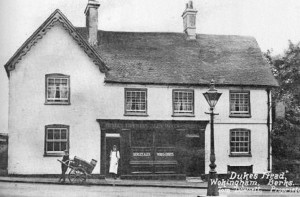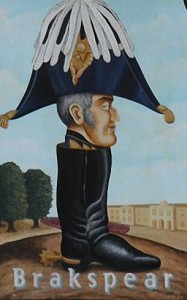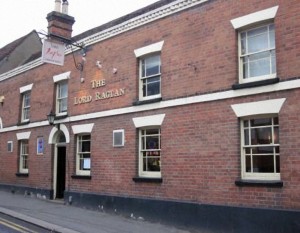200 years of Wokingham, Wellington and Waterloo 1815 – 2015
This article appears in the first edition of the Wokingham Paper. If you would like to add to it, comment or criticise it (heaven forbid) please go to the comments section at the bottom of this page.
On the 18th June 1815, the Duke of Wellington’s Allied force defeated Napoleon at Waterloo in Belgium. In the coming months therefore, there will be much ceremony as the nation remembers this history defining moment.
During the early part of the 19th century, Wokingham like the rest of the country bristled with pride over the victory and the town provides evidence of this approval in many of its names; Waterloo Road and the Wellington Road are both in Wokingham. There was also the Wellington Brewery in Denmark Street and two pubs still existing are the Lord Raglan and the Duke’s Head. Wellington lived in Stratfield Saye, (just a 30 minute drive from Wokingham) and Crowthorne’s Wellington College was built in his honour and completed in 1859. The development of the College was to educate the orphaned sons of Wellington’s fallen men and is just a short 15 minute drive from Wokingham’s town centre.
‘Who’d a Tho’t it’ !
Out of that pride in victory grew a few tall stories; two pubs in the area, the ‘Who’d a Tho’t it’ of the Nine Mile Ride and the Dukes Head, both attached themselves to the legendary Iron Duke.
The story goes that the Duke’s entourage decided to take a break on their homeward journey to Stratfield Saye and came upon an old beer house on the Nine Mile Ride. Having been treated to a display of welcome by the beer keeper, the Duke raised his glass to his now merry throng and declared the visit a success. “By Jove, who would have thought it!” he declared. The legend was thus born that the publican named the pub thereafter the ‘Who’d a Tho’t it’!
It’s a good yarn and would certainly have brought in a few curious customers. The story however starts to wobble when the pub shares its name with other pubs in other parts of the country. The story sadly starts to disintegrate further when a more plausible alternative appears. A book on Wokingham pubs by local historians Ayres and Hunter, quoted Bryant Lilywhite’s theory that baronies were being bestowed upon wealthy brewers and a wag came up with: ‘Who’d ha’ thought it …. Hops had bought it’.

The Duke’s Head is closely associated with the Duke of Wellington. Dates though tell a different story
Local historian Roger Long waded in with another theory. Sailors wounded during the Napoleonic wars would live amongst the ‘broom dashers’ of the local forest and made various nautical exclamations of unexpected pleasure; one being ‘By Woden and Thor’! The term gradually became corrupted from ‘Woden and Thor’ to ‘Who’d a Th’ot it’ !
The Dukes Head Public House
Another legend has grown up around the name of The Dukes Head in Denmark Street, Wokingham. This pub has a painting on the external wall of a gentleman with a prodigious nose and whose head is peeping out of a wellington boot making it very obvious which Duke the Duke’s Head is named after.
However, Wellington was made a Duke in 1814, whereas the name, The Dukes Head appears in 1791 when it is advertised in the Reading Mercury newspaper. The pub’s name therefore couldn’t belong to Wellington and was more likely a reference to the Duke of St Albans who was Wokingham’s High Steward during the 1700’s. Another coup for the Ayres Hunter historians!
The Lord Raglan (Denmark Street)
We mentioned the Lord Raglan earlier and you might be puzzled over the reference to the name. He was after all, more closely connected to the Crimean War (the one in 1853 – 1856) and was pilloried by the press for being responsible for both the appalling conditions of the soldiers and The Charge of the Light Brigade. Legend has is it that this tough old campaigner had his arm amputated and soon after spent some time looking for it to retrieve a ring which was a gift from his wife. Dysentery and depression had killed him prior to the end of the war and the Wellington connection is that he was the Duke’s military secretary.
And the point is…
History is peppered with theories which become fascinating in their own right, raising even more questions than answers. Who was Woden ? Did you know about the Duke’s association with the area? Who were these sailors living among the broom dashers in the forest? And who on earth were the broom dashers? It becomes endlessly fascinating, especially as it hints of a dark past.
If you can help enrich this article either write to the Wokingham Paper or place a comment on the same page in www.wokinghamremembers.com
Our thanks to:
- Roger Long’s research supports this article and he continues to amaze and entertain; keep an eye out for his new book ‘The Broom Dashers’.
- The book ‘The Inns and Public Houses of Wokingham’ was started by Anthony Cross and following his death in 1986 was completed by Dennis Ayres and Judith Hunter in 1992.
- Chris French and his excellent set of pub photos and biographies on www.frogslegs.org




